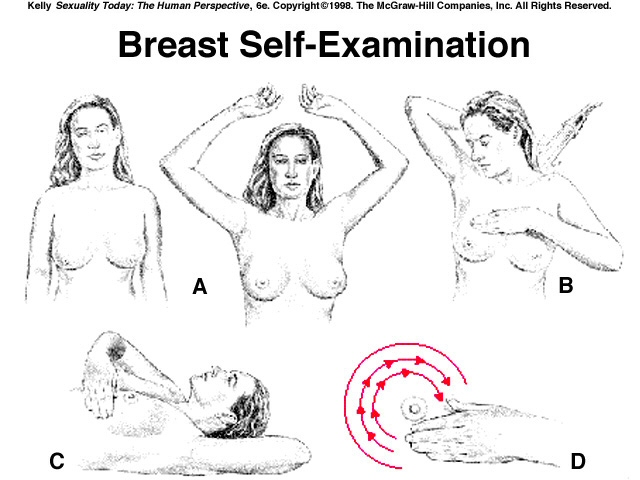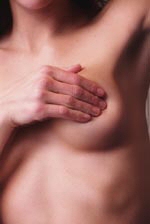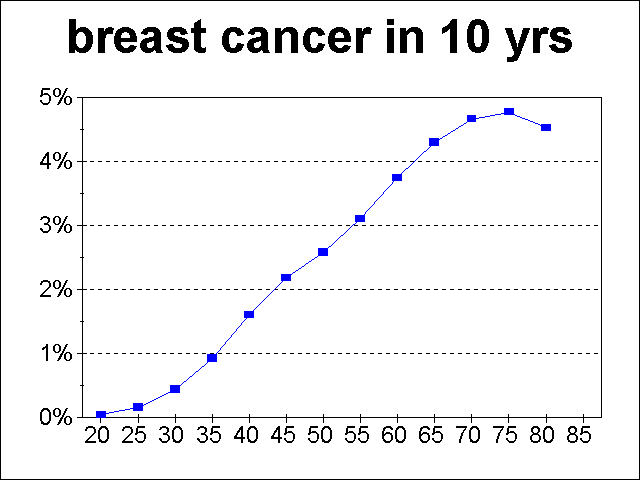What is a breast self-exam?
A breast self-exam is a monthly exam a woman can do herself to check for breast cancer. When you do a breast self-exam you check for lumps, thickening, dimples in the breast, or discharge from the nipple.
Cancer of the breast is the most common type of cancer in American women. About 1 in every 9 women develops breast cancer. Most cases of breast cancer are discovered by women doing self-exams. When breast cancer is found early and treated right away, the chances for cure are better. Every woman should do regular breast self-exams.
What is the best time to examine my breasts?
Examine your breasts once a month at the end of your period, when your breasts usually aren't tender or swollen. If you have already been through menopause or have had a hysterectomy, check your breasts on the first day of every month or whenever you can best remember to do it monthly.
How do I do a breast self-exam?
A breast self-exam consists of the following five steps:
Step 1: Examine your breasts in the shower or bath. Your hands move more easily over wet skin. With your fingers flat, move gently over the entire area of each breast, checking for any lump, hard knot, or thickening (image B).
Step 2: Look at your breasts while standing in front of a mirror (image A). Look at them first with your hands at your sides, then with your hands raised over your head, then with your hands pressed firmly on your hips so that your chest muscles are flexed. Look for lumps, new differences in size and shape, and swelling or dimpling of the skin. It is usually normal for your right and left breasts not to match exactly.
Step 3: Examine your breasts with your fingers while sitting or standing. Slowly and methodically press on a breast with the fingers of the opposite hand. With your fingers flat, work in a circular or spiral direction, beginning at the nipple and moving gradually outward (image D).
Step 4: Lie down and repeat step 3 (image C). Put a small pillow or rolled up towel under your shoulder on your left side and put your left arm under your head. This distributes the breast tissue more evenly on your chest. Use your right hand to examine your left breast, as in step 3, then use your left hand to examine your right breast. Feel for any lumps or thickening which cannot be felt in the same area in the other breast.
Step 5: Squeeze the nipple of each breast gently between your thumb and index finger. Report any discharge or fluid to your doctor immediately.
When should I call the doctor?
If you find a lump, dimple, or discharge during your breast self-exam, see your doctor as soon as possible. Don't be frightened. Most lumps are not cancerous, but only your doctor can make the diagnosis. Call the Student Care Center and make an appointment with a Womancare provider (702-4156).


Developed by Phyllis G. Cooper, R.N., M.N., and McKessonHBOC Clinical Reference Systems.
Information and poster from: http://scc.uchicago.edu/breastselfexam.htm
Breast Cancer Rate in 10 Years
The Probability of Getting Breast Cancer in the Next 10 Years for females versus current age. Source: American Cancer Society, in SDUT 10/7/97, E3.

From: Human Mortality and Health Problems
If you are interested, Regina found a beautiful survivor's pin a talented lady made. You can purchase it from her site:
LLD'zines
Other Sources to Check Out
Regina found some interesting sites you might want to check out.
RAOK's Pink Ladies
http://scc.uchicago.edu/breastselfexam.htm
http://sd.znet.com/~schester/facts/
lldzines.com/breast-cancer/survivorspin.htm
http://www.cancer-info.com/breast.htm
http://www.cancer-info.com/selftest.htm
This page put together using pictures, information, and sites found by Regina exclusively for Mothering the Spirit. Her information and pictures were also used on other pages.